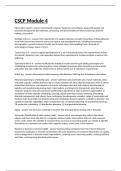CSCP Module 4
Information system - answer-interrelated computer hardware and software along with people and
processes designed for the collection, processing, and dissemination of info for planning, decision-
making, and control
Strategic info & it - answer-info required by it to support decisions includes broad base of data gathered
from both internal and external sources at tactical and operational levels, including noncustomer
demographics, general economic trends, and in some cases, data resulting from a forecast of
technological change; spans 5-10 yrs
Tactical info & it - answer-support development of a set of functional plans; info requirements include
the period's demand, costs, and capacities derived from operational it; involves analysis as well as info
gathering
Operational info & it - answer-facilitated by analytical it tools used for goal setting and targets and
establishing measures for achieving plans; s&op; designed to execute plans formed in previous levels
and gather the info needed for those levels as well as satisfy acct & regulatory requirements
Active tag - answer-self-powered radio frequency identification (rfid) tag that broadcasts information
Advanced planning & scheduling (aps) - answer-optimizes and accelerates use of avail materials, labor,
and plant capacity; satisfies business obj to create schedules for what shud be produced, when & where
production shud occur, and sequence of events; techniques that deal with analysis and planning of
logistics and manufacturing during short, intermediate, and long-term time periods; describes any
computer program that uses advanced mathematical algorithms or logic to perform optimization or
simulation on finite capacity scheduling, sourcing, capital planning, resource planning, forecasting,
demand management, and others; these techniques simultaneously considers range of constraints and
business rules to provide real-time planning and scheduling, decision support, available-to-promise, and
capable-to-promise capabilities. Main components are: (1) demand planning; (2) production planning;
(3) production scheduling; (4) distribution planning; (5) transportation planning
Agent - answer-one who acts on behalf of another (the principal) when dealing with a 3rd party
Automatic identification & data capture (aidc) - answer-set of technologies that collect data about
objects and then sends the data to a computer without human intervention (rfid, bar code scanners,
smart cards); faster info visibility & increased trans accuracy & processing speed; can classify & identify
themselves on a network; bar codes, rfid, magnetic stripes, smart cards, vision systems
Business-2-business commerce (b2b) - answer-business being conducted over the internet between
businesses; implication is that this connectivity will cause businesses to transform themselves via supply
chain management to become virtual organizations, reducing costs, improving quality, reducing delivery
lead time, and improving due-date performance
, Business-2-consumer sales (b2c) - answer-business being conducted between businesses and final
consumers largely over the internet; includes traditional brick-and-mortar businesses that also offer
products online and businesses that trade exclusively electronically
Capable-2-promise (ctp) - answer-process of committing orders against available capacity as well as
inventory; may involve multiple manufacturing or distribution sites; used to determine when a new or
unscheduled customer order can be delivered; employs a finite scheduling model of the manufacturing
system; includes any constraints that might restrict the production, such as availability of resources, lead
times for raw materials or purchased parts, and requirements for lower-level components or
subassemblies; resulting delivery date takes into consideration production capacity, the current
manufacturing environment, and future order commitments; objective is to reduce the time spent by
production planners in expediting orders and adjusting plans because of inaccurate delivery-date
promises
Data cleansing - answer-sifting through a database to find and fix mistakes such as misspelling, missing
information, and false data
Data dictionary - answer-(1) catalog of requirements and specifications for an information system; (2)
file that stores facts about the files and databases for all systems that are currently being used or for the
software involved
Data normalization - answer-relational database procedure that helps to minimize data duplication and
protect the database from certain logical and structural anomalies when data is merged
Database management system (dbms) - answer-software designed for organizing data and providing the
mechanism for storing, maintaining, and retrieving that data on a physical medium; separates data from
the application programs and people who use the data and permits many different views of the data
Electronic commerce (e-commerce) - answer-use of computer and telecommunication technologies to
conduct business via electronic transfer of data and documents
Electronic product codes (epcs) - answer-codes that are used with rfid tags to carry information on the
product that will support warranty programs; has same info as sku plus unique serial # identifying
instance of product (making it unique); goal is to minimize info content, product categorization,
computation needs, & data storage
Enterprise resource planning (erp) - answer-framework for organizing, defining, and standardizing the
business processes necessary to effectively plan and control an organization so the organization can use
its internal knowledge to seek external advantage; provides visibility and efficiency to see where
business is going and where it can be steered; brings company to stage 3 of sc development (integrated
enterprise); based on model of sc
Extensible markup language (xml) - answer-language that facilitates direct communication among
computers on the internet; tags in this language give instructions to a web browser about the category
of information
Extranet - answer-network connection to a partner's network using secure information processing and
internet protocols to do business




